How to Upload Photos From Flashair Drive to Laptop
We're close to the end of 2019, then I don't demand to tell you lot that everything at present has to exist able to connect to a WiFi network due to the massive convenience cistron, merely, while some devices take been quick to go a built-in wireless adapter (the entire IoT department is in booming), there are some fields where this transition happens slowly and upgrading often is not really an option.
I of information technology is the photography department where the gear feels fresh for a long period of fourth dimension and the price tag is very loftier, so you volition most probable stop upward keeping a good camera for more than a couple of years (while investing more than in lenses). The trouble is that older cameras don't accept WiFi capabilities (which is truly more than of an inconvenience than a problem), so, to gain the power to easily transfer your footage and photos to your estimator, you demand to apply a WiFi SD card.
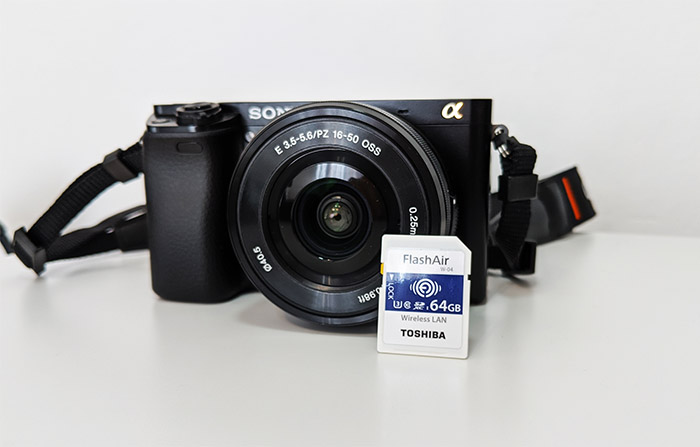
Well, it'south easier said than done since there really aren't that many players in this field, since it'due south kind of a dying market, but besides cameras, which were for the longest time the main application, you lot can besides apply them with 3D printers, a blazon of device which just recently has started to become a common thing in the tech world. That being said, while Center-Fi has pretty much abandoned its devices, in that location'southward however Toshiba with its FlashAir West-04 WiFi SD card to fill in the void and to provide the means to rapidly and securely transfer data from your cameras (or 3D printers) to your computer. Of class, there are some expectations that demand to exist met, so allow'southward have a closer look and see if the quaternary generation of WiFi SD cards are worth taking into consideration.
Design and Functionality
After you take it out of the package, you can immediately run across that the Toshiba FlashAir W-04 looks exactly like the other SD cards on the market, but there is one major divergence: it'due south non microSD, so it's as large equally your SD adapters. This means that yous won't be able to use it with all your devices, just you should be able to insert it in nearly (if not all) DSLR or mirrorless cameras, as well as some compatible laptops (in that location are as well some cheap dongles that you can employ with your almost-port-less ultrabooks or MacBooks).
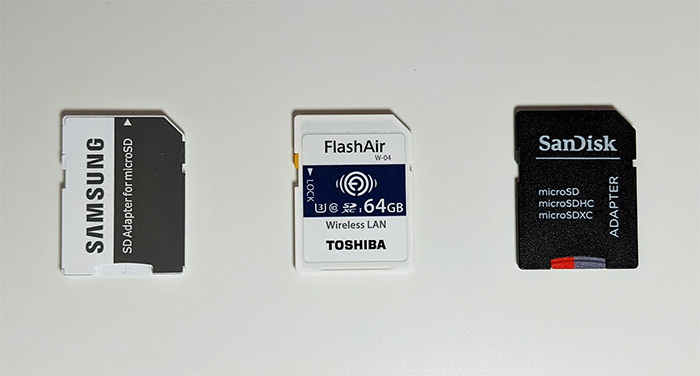
The SD card itself is made of plastic and it'southward completely white with some info labels on the front and rear side and merely like whatever other SD adapter, there's a pocket-size Lock switch to enable the write-protected mode (yep, it'due south notwithstanding hardware-based); furthermore, the device is made in Japan, which is always prissy to see. It also has the aforementioned size as the regular SD adapter (information technology measures 1.25 10 0.94 x 0.08 inches), simply you can come across that there is no slot for the microSD carte – the wireless LAN chipset and the WiFi antenna are positioned inside the plastic enclosure, so like I said before, at that place really isn't any element that gives information technology abroad that this is a WiFi SD card.
The model that I got is the SDXC 64GB USH-3 SD card which means that the default format is exFAT, the bus interface speed is up to 104MBps and the U3 Class suggests that the minimum sequential write speed is 30MBps (therefore, more suitable for both 1080p and 4K videos). Since it'south SDXC, you lot need to ensure that your camera is compatible and tin can support SD cards equal or larger than 64GB. In whatsoever instance, Toshiba also offers a 16GB likewise as a 32GB SDHC I model and it'due south worth noting that the 64GB variant is something sectional to the newer generation (the previous gen spanned from 8 to 32GB), not that this is an boggling offering in terms of storage (the most usually used starts from 128GB). Besides the storage improvement, the other differences betwixt the 2 generation (W-03 vs W04) is by and large seen in the app functionality simply before delving into it, allow's accept a quick look over the installation process.
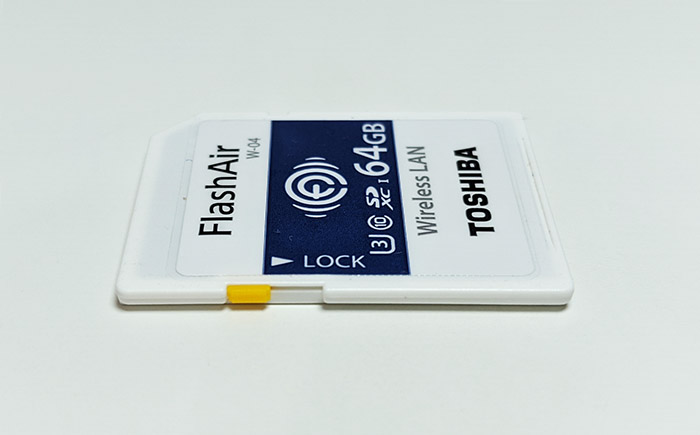
The first thing that you should do is decide on which device y'all volition install the app (the smashing matter nearly this SD menu is that it tin can connect to seven devices at the same fourth dimension) and, if yous're going the Android route similar I did (the relatively old, reliable Pixel ii XL since I'k also cheap for an iPhone) then yous should install the FlashAir app from the Google Play but, while for some users this worked flawlessly, it didn't for me and the app would never connect to the SD bill of fare.
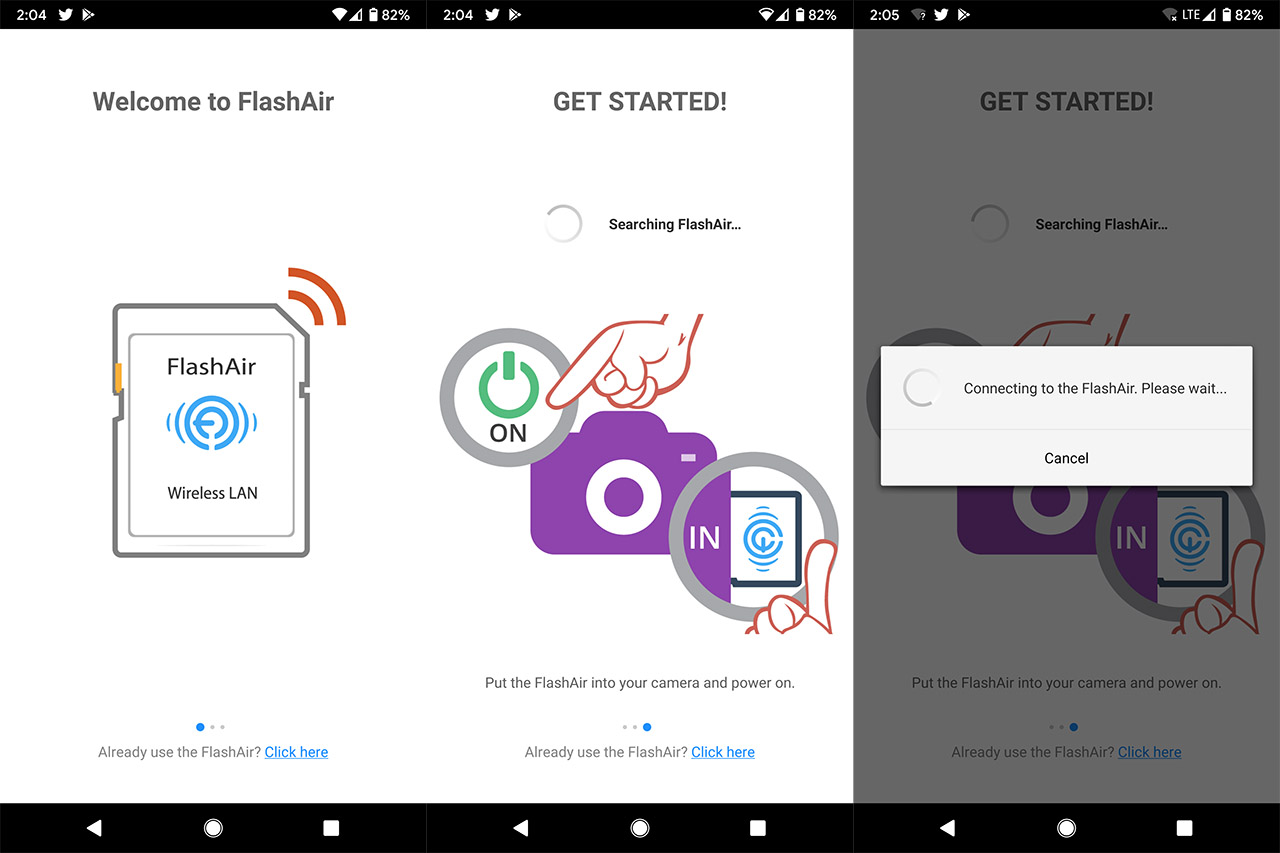
It's a nicely designed app and all, but information technology'due south rubbish, so, to actually get to use the SD card you will have to connect to the dedicated WiFi network (should exist something similar flashair_ecxxxx and the default password is 12345678) and yous should get access to a rather rudimentary user interface with some folders. Every time you have a photograph or video, this UI volition immediately ship them to your smartphone (a JPEG photograph took about 2 seconds to appear on my phone) and, of grade, depending on how long the video you just shot is, it could take a while until yous'll be able to bank check it out on your mobile device. The same approach can be used to check out the footage from a computer or tablet.
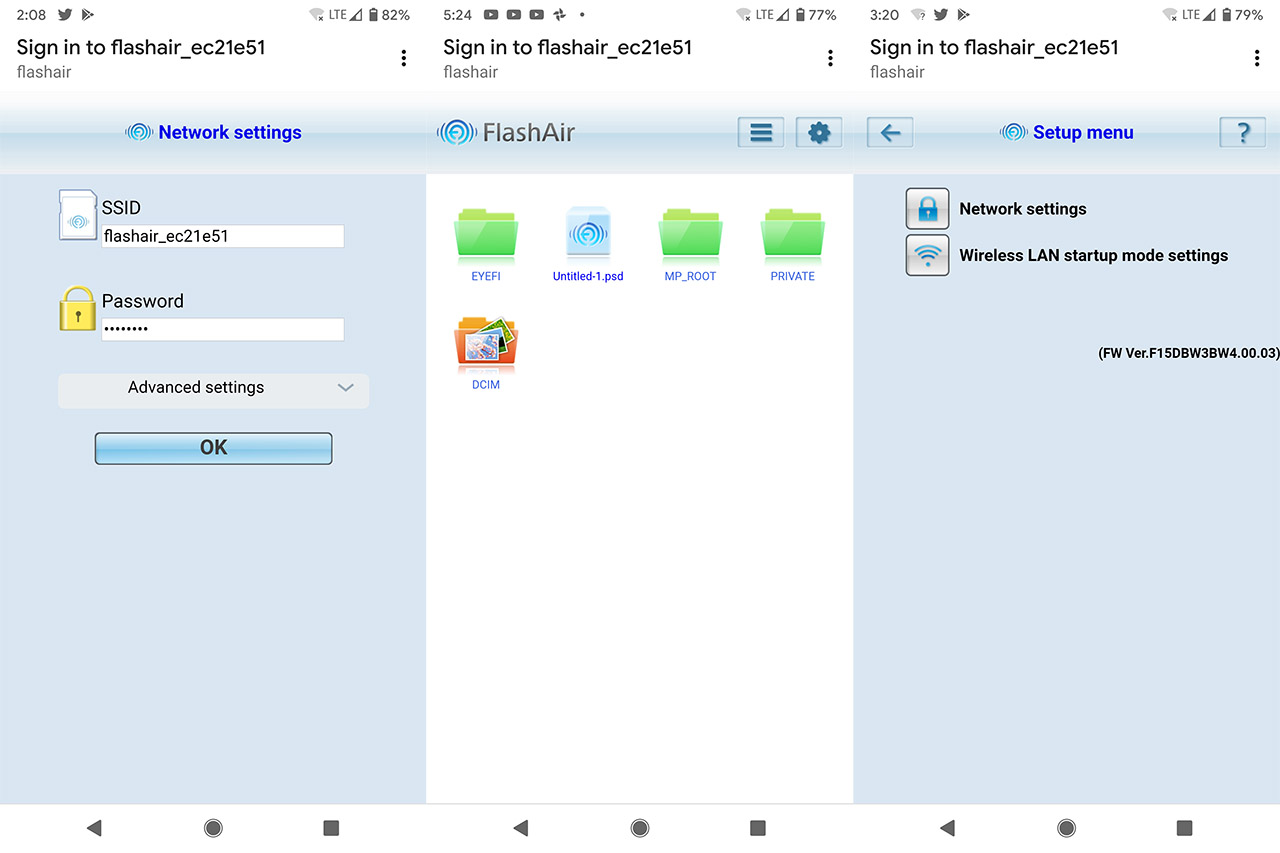
Besides checking out the files added almost in real time, at that place is a modest cogwheel which when tapped, it opens the Setup bill of fare: hither, y'all tin modify the Network settings (the SSID and Password – you lot can also use the aforementioned network settings even after the card has been formatted or reset the network settings to their initial land) or conform the Wireless LAN startup style settings (if left on the Automatic startup mode, and then it volition run immediately after the device that holds the bill of fare is turned on and, in Manual startup mode, it will require you to prepare a wireless LAN startup image which when set to unprotected, it will turn on the wireless functions of the card and, if information technology's fix to protected, the wireless functions will be turned off – very easy and directly frontward…).
Annotation: I did check the compatibility with Android devices and it seems that it should work with version Five.4.1 to V8.0, so, maybe v9.0 and v10 aren't yet supported.
Adjacent, it's fourth dimension to insert the SD card into a Windows 10 auto and, once once more, I tried to follow the provided instructions: went to http://www.toshiba-personalstorage.cyberspace/ww/support/download/flashair/config.htm, scrolled downwardly to Download Software and clicked on the Configuration Software, 'read' and accepted the End User License Understanding and then I finally got to download the FlashAir Configuration Software for Windows.
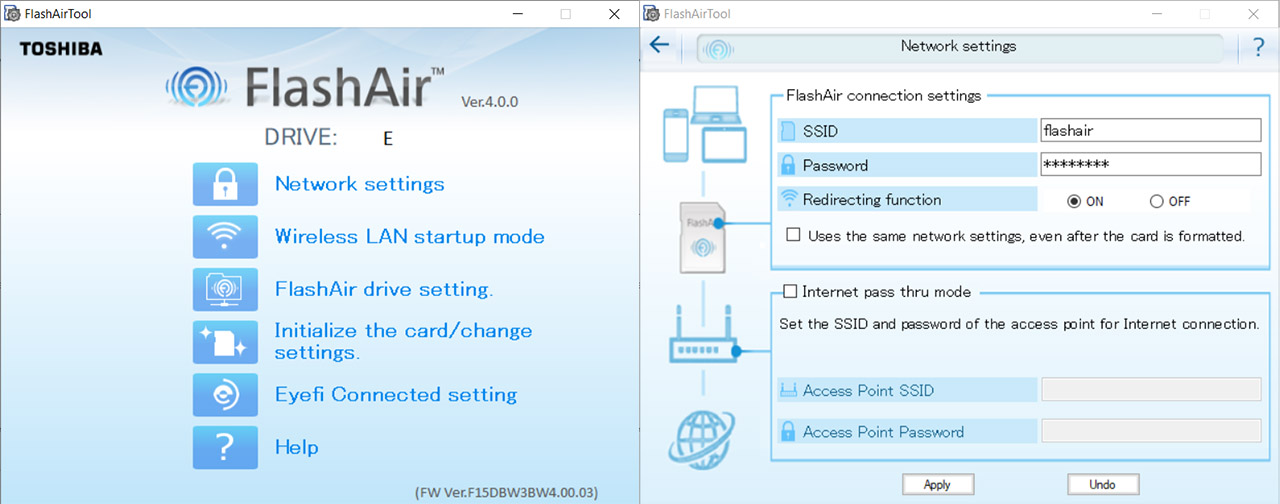
Later on installing the FlashAirTool, I opened information technology and was greeted past a pocket-size window where it said the version of the software, the Bulldoze letter, besides as some settings. Offset, yous'll be able to alter the Network settings (the SSID and password, whether y'all want the Redirecting office – you exercise since the mobile app doesn't piece of work – and if you desire to enable the Internet laissez passer-through mode, which is basically enabling the Admission Point mode), enable the Wireless LAN startup mode (Automatic or Manual), enable the FlashAir bulldoze setting (it volition work as a network drive, so you tin view and copy files from the SD card to your PC via wireless), Initialize the card or enable the Eyefi Continued setting (the camera will not plow off when the SD card transfers data).
I currently have no iPhone, but I practise use a MacBook Pro from time to fourth dimension (I'yard still on Tim Melt's whitelist), so I decided to attempt and connect the SD card to it using a USB-C dongle and running through pretty much the same steps every bit on a Windows auto, I did get quick access to the configuration page and could alter diverse aspects about the menu.
Earlier finishing up, I thought it would be interesting to see the storage performance of the SD card using a couple of constructed benchmarks.
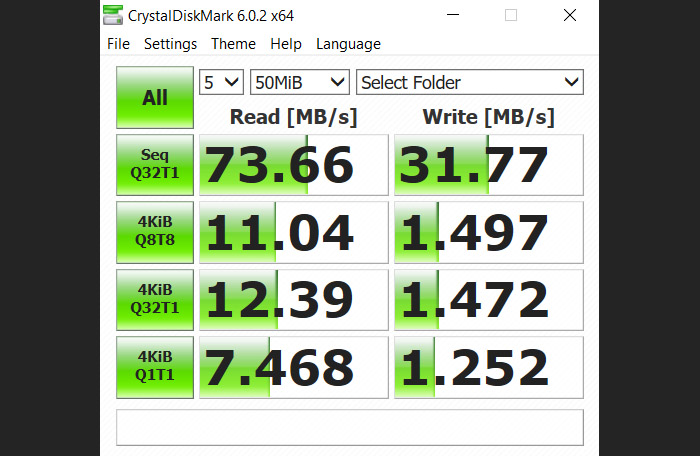
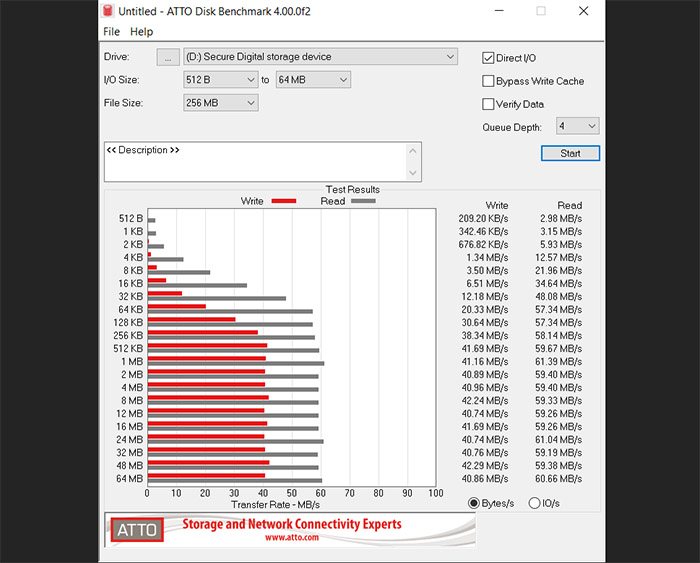
That being said, using the CrystalDiskMark 5.6.0.2, the sequential read speed was 73.6 MBps and the sequential write speed was 31.vii MBps. The ATTO synthetic benchmark showed an average of 40MBps for writing files from 512KB to 64MB and between 57 to 61 MBps for reading files from 64KB to 64 MB, so information technology is in line with what was advertised.
Conclusion
At that place really aren't that many WiFi SD cards on the market (less today than a few years ago), so the fact that Toshiba has kept this line alive until at present is definitely promising, although I exercise expect that at some point there volition be no need for this type of devices anymore. Simply this is not that time and our powerful, yet old cameras still need a way to connect to the Cyberspace and the FlashAir W-04 WiFi SD carte definitely does that for you. In that location is a problem with the Android app (doesn't connect to the menu), only there is a quick work-around and if you lot desire to alter some settings, you can easily connect the card to either a MacBook or to a Windows computer.
Check the production here:
![]()
FlashAir West-04 WiFi SD card
-
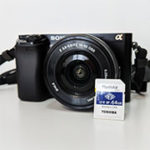
Pros
- Quick information transfer between the SD carte du jour and a mobile device
- Has some useful features, such as Eyefi
- Can work as an Access Point
- Can connect to seven devices at the same time
Cons
- The Android app doesn't connect to the SD card
- Some settings are confusing

Mark is a graduate in Information science, having gathered valuable feel over the years working in IT equally a developer. Mark is also the main tech writer for MBReviews.com, covering not only his passion, the networking devices, merely also other absurd electronic gadgets that you may find useful for your every 24-hour interval life.
Source: https://www.mbreviews.com/toshiba-flashair-w-04-wifi-sd-card-review/
0 Response to "How to Upload Photos From Flashair Drive to Laptop"
Post a Comment